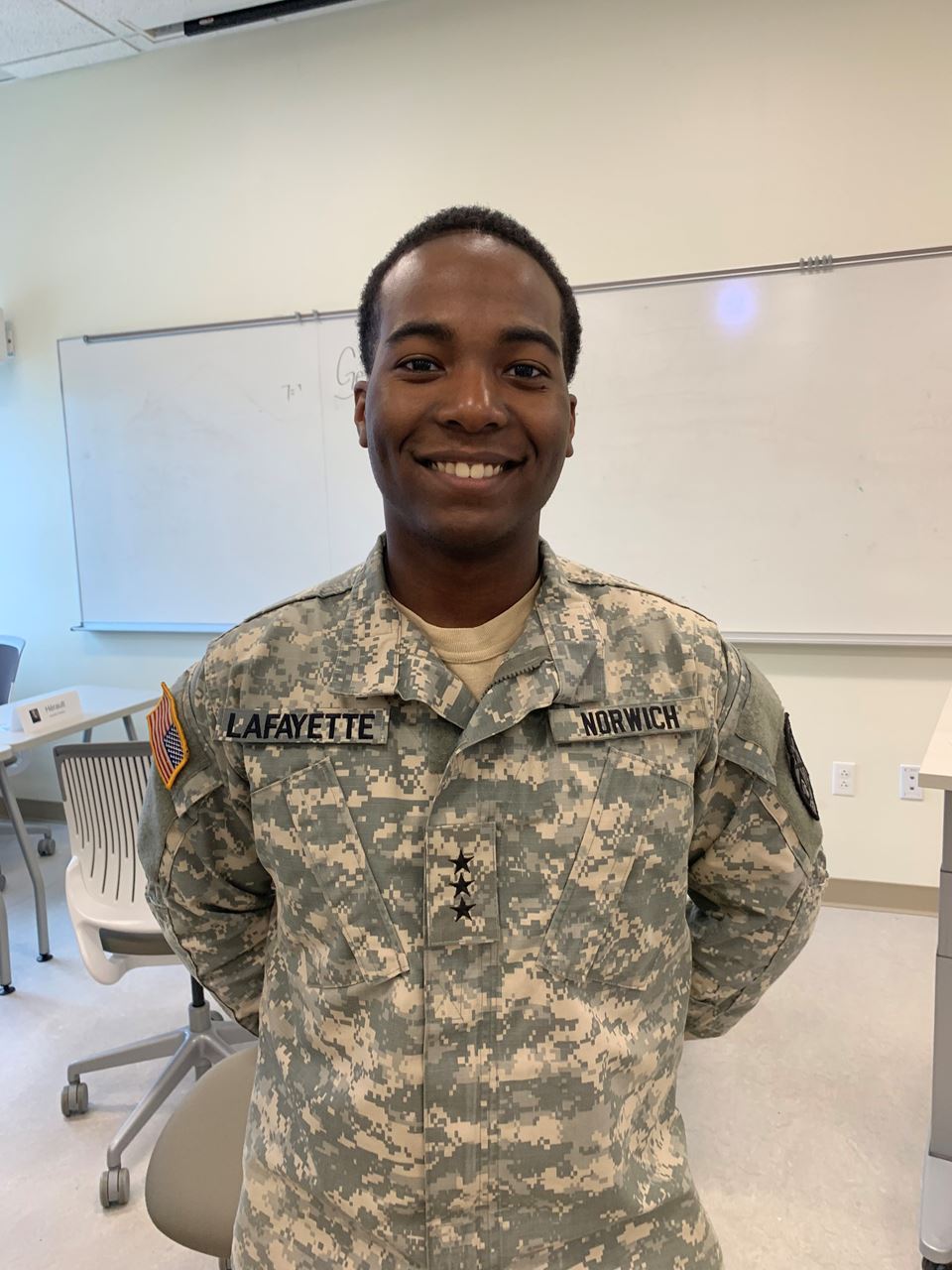
By: Emily Fisher Gray
Professor of History
Norwich University, The Military College of Vermont
I like to wear my Athena costume on the first day of my Freshman Seminar class and jump right into Athens Besieged. It’s a memorable first day of college for the students and a better introduction to what will happen in a Reacting to the Past based class than the typical syllabus day. The only downside for me is the heat: it’s late August in Vermont, classrooms do not have air conditioning, and I am wearing a second costume underneath the first..jpg) Norwich University was founded 200 years ago to train military officers and nods to that tradition by having faculty and most students wear military-style uniforms. So under my Athena robes or other Reacting-inspired regalia I wear the uniform of a Colonel in the Vermont State Militia, styled after the “Army Greens” Class A uniform of the US Military. Students in my classroom wear the prescribed uniform of the day: usually a white shirt with gray trousers or camouflage field service uniform. Thus, on the first day of Freshman Seminar, a slightly-overheated Athena looks out over a sea of first-year students in identical clothing with identical haircuts and tells them that they are not freshmen, not recruits (“Rooks”) in the Corps of Cadets, but Greeks who must figure out how to respond to the Spartan siege of Athens. It is a testament to the power of Reacting that these students, who have recently made the challenging transition from high school graduate to Rook in the Norwich Corps of Cadets, transform again so quickly into Athenian citizens and immediately jump in to solve a whole new set of problems.
Norwich University was founded 200 years ago to train military officers and nods to that tradition by having faculty and most students wear military-style uniforms. So under my Athena robes or other Reacting-inspired regalia I wear the uniform of a Colonel in the Vermont State Militia, styled after the “Army Greens” Class A uniform of the US Military. Students in my classroom wear the prescribed uniform of the day: usually a white shirt with gray trousers or camouflage field service uniform. Thus, on the first day of Freshman Seminar, a slightly-overheated Athena looks out over a sea of first-year students in identical clothing with identical haircuts and tells them that they are not freshmen, not recruits (“Rooks”) in the Corps of Cadets, but Greeks who must figure out how to respond to the Spartan siege of Athens. It is a testament to the power of Reacting that these students, who have recently made the challenging transition from high school graduate to Rook in the Norwich Corps of Cadets, transform again so quickly into Athenian citizens and immediately jump in to solve a whole new set of problems.
Many faculty who use Reacting to the Past pedagogy find that costumes help create the liminal space that turns a college classroom into an ancient city under siege, or a medieval city council chamber, or a meeting of the United Nations General Assembly. At a military university where most students are in uniform, however, costumes pose a unique set of challenges. My students at Norwich University have a very limited wardrobe. They are each allowed one footlocker which contains only the clothing items they are issued: various formal military-style uniforms; a plain t-shirt, shorts, and reflective belt for physical training; and a fluffy maroon bathrobe. There is not much variety, or many options for obtaining other items in rural central Vermont, even after the Rooks are “recognized” as full members of the Corps and given permission to go off campus. Further complicating the issue of costumes in uniform, many of my students are under contract with various branches of the military. They are not wearing the Norwich student Corps of Cadets uniform, but one issued to them by the Navy, Marines, Army, or Air Force. Sometimes, students in “real” military uniforms hesitate to mix uniform pieces or wear hats or other items that are not within military regulations, even for a class activity. As a faculty member I have always enjoyed strong support from the ROTC Colonels and the Commandant of Cadets, who have always given permission for students to be out of the standard uniform for academic purposes, but I make costumes optional for students out of respect for those who feel uncomfortable wearing their uniform in a way they view as improper.
Given the challenge of costumes for uniformed students on a military campus, I am continually amazed by their creativity. Students frequently mix and match uniform pieces to create fashions that are historically plausible and serve to help visually mark the classroom space as different. .jpg) Of all the contents of their footlockers, the bathrobe has proven to be the most versatile item. It works effectively to transform a student into a Roman Senator and equally well to distinguish members of the Crowd in the French Revolution. One enterprising student turned the waist tie of the bathrobe into a passable cravat, and since then many students have followed his example, stuffing it into the neckline of their shirts to become aristocrats during games set in early modern Europe. The reflective PT belt can be worn across the body as a sash and though it lacks a certain gravitas, it can serve effectively as a marker of faction identity. Cardboard Bishop’s Miters, helmets, crosses, and other items are easy for students to make and wear during an RTTP game, and the end of a game is frequently marked by a recycling bin overflowing with interesting handmade objects.
Of all the contents of their footlockers, the bathrobe has proven to be the most versatile item. It works effectively to transform a student into a Roman Senator and equally well to distinguish members of the Crowd in the French Revolution. One enterprising student turned the waist tie of the bathrobe into a passable cravat, and since then many students have followed his example, stuffing it into the neckline of their shirts to become aristocrats during games set in early modern Europe. The reflective PT belt can be worn across the body as a sash and though it lacks a certain gravitas, it can serve effectively as a marker of faction identity. Cardboard Bishop’s Miters, helmets, crosses, and other items are easy for students to make and wear during an RTTP game, and the end of a game is frequently marked by a recycling bin overflowing with interesting handmade objects.
 Sometimes it takes very little to transform a student’s uniform into the perfect Reacting to the Past costume. Military uniforms are covered with patches, badges, ribbons, and epaulets that communicate everything someone would need to know about that person’s military rank and previous experience, like a wearable resume. People who have served in the military are attuned to these visual cues and can instantly “read” a uniform. I never served in the military, so when one of my students came up to me the day we started French Revolution and asked me how I liked his costume, I was confused. It looked like his standard Norwich-issued Corps of Cadets field uniform to me, until I looked closer. He had replaced his cadet rank with three stars and his name tape with “Lafayette.” Naturally, his fellow students noticed it right away. The change was small, but extremely effective. There is nothing this student could have done to more effectively signal his leadership status to a room full of students attuned to the visual cues on a military uniform.
Sometimes it takes very little to transform a student’s uniform into the perfect Reacting to the Past costume. Military uniforms are covered with patches, badges, ribbons, and epaulets that communicate everything someone would need to know about that person’s military rank and previous experience, like a wearable resume. People who have served in the military are attuned to these visual cues and can instantly “read” a uniform. I never served in the military, so when one of my students came up to me the day we started French Revolution and asked me how I liked his costume, I was confused. It looked like his standard Norwich-issued Corps of Cadets field uniform to me, until I looked closer. He had replaced his cadet rank with three stars and his name tape with “Lafayette.” Naturally, his fellow students noticed it right away. The change was small, but extremely effective. There is nothing this student could have done to more effectively signal his leadership status to a room full of students attuned to the visual cues on a military uniform.
With such a limited wardrobe to work with during their college years, some students find the option to wear a costume for class to be a liberating experience. Another of my Lafayettes, a chemistry major on the verge of graduating and commissioning as a Navy 2nd Lieutenant, ordered a complete 18th century French officer’s uniform online. Our class met at 8:00am, so the student had simply no choice but to dress as the Marquis de Lafayette for the daily Corps of Cadets formation at 7:45 before coming to class. When the semester ended, I offered to find a home for this wonderful outfit in my costume closet, but the student demurred: he was pretty sure he would need to use it at some point during his career as a naval officer. Students connected with Pegasus Players, our on-campus drama society, also come up with some great costumes. One semester, a male student assigned to the French Revolution role of Marguerite Andalle proudly wore a bonnet and fancy dress to class each day. For these students, the option to dress in costume for a Reacting to the Past game gave them the perfect opportunity to be transgressive and safely push back against the limitations of a military campus that otherwise offers little opportunity for self-expression through clothing. Mikhail Bakhtin would be proud.
Costumes are not the only way to signal that students have entered a liminal space in a Reacting to the Past classroom. I hang banners and flags, play music, and sometimes move the class to a different location for the duration of a game. Students have debated responses to the Black Plague in our campus chapel and led the French Revolution from an indoor tennis court, for example. But even on a military campus with limited access to historical attire, allowing students the option to dress in costume for Reacting to the Past games gives them opportunities to exercise creativity and have some fun while getting into character.
About the Author
Emily Fisher Gray is a Professor of History at Norwich University, where she also serves as the Vice Chair of the Faculty Senate. Gray has written on the early causes and progress of the Protestant Reformation, the phenomenon of Lutheran-Catholic co-existence, and the unique aesthetics of Lutheran architecture. Her ongoing research takes place in churches, libraries and archives in the former Free Imperial Cities of southern Germany, especially Augsburg, where she lived for a year as a Fulbright Fellow. She has written a Reacting game "Wrestling with the Reformation: Augsburg, 1531."
Blog Author Questionnaire
One word to describe faculty: Curious
Two words to describe your school: Liberal-arts, military
Three words to describe students: Enthusiastic, Open-minded, Game-breakers
Four words to describe favorite games: Armies, Duels, Sausages, Votes
Five words to describe Reacting: Transformational, Challenging, Brilliant, Engaging, Essential



